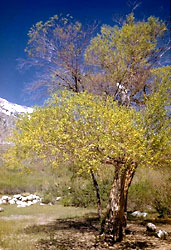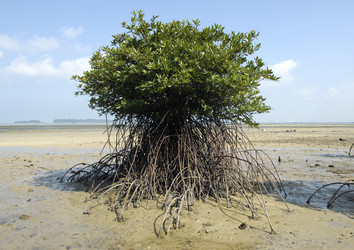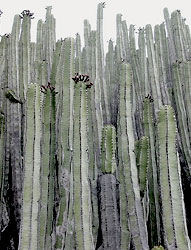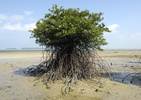Malpighiales



This tree diagram shows the relationships between several groups of organisms.
The root of the current tree connects the organisms featured in this tree to their containing group and the rest of the Tree of Life. The basal branching point in the tree represents the ancestor of the other groups in the tree. This ancestor diversified over time into several descendent subgroups, which are represented as internal nodes and terminal taxa to the right.

You can click on the root to travel down the Tree of Life all the way to the root of all Life, and you can click on the names of descendent subgroups to travel up the Tree of Life all the way to individual species.
For more information on ToL tree formatting, please see Interpreting the Tree or Classification. To learn more about phylogenetic trees, please visit our Phylogenetic Biology pages.
close boxReferences
Chase, M. W., S. Zmarzty, M. D. Lledó, K. J. Wurdack, S. M. Swensen, and M. F. Fay. 2002. When in doubt, put it in Flacourtiaceae: A molecular phylogenetic analysis based on plastid rbcL DNA sequences. Kew Bulletin 57:141-181.
Davis, C. C. and M. W. Chase. 2004. Elatinaceae are sister to Malpighiaceae; Peridiscaceae belong to Saxifragales. American Journal of Botany 91(2): 262-273.
Davis, C. C., M. Latvis, D. L. Nickrent 2, K. J. Wurdack, and D. A. Baum. 2007. Floral gigantism in Rafflesiaceae. Science: DOI: 10.1126/science.1135260
Davis, C. C. and K. J. Wurdack. 2004. Host-to-parasite gene transfer in flowering plants: Phylogenetic evidence from malpighiales. Science 305(5684):676-678.
Litt, A. J. and M. W. Chase. 1999. The systematic position of Euphronia, with comments on the position of Balanops: An analysis based on rbcL sequence data. Systematic Botany 23:401-409.
Merino Sutter, D. and P. K. Endress. 2003. Female flower and cupule structure in Balanopaceae, an enigmatic rosid family. Annals of Botany 92: 459-469.
Qiu, Y. L., J. H. Lee, F. Bernasconi-Quadroni, D. E. Soltis, P. S. Soltis, M. Zanis, E. A. Zimmer, Z. D. Chen, V. Savolainen, and M. W. Chase. 2000. Phylogeny of basal angiosperms: Analyses of five genes from three genomes. International Journal of Plant Sciences 161:S3-S27.
Savolainen, V., M. W. Chase, S. B. Hoot, C. M. Morton, D. E. Soltis, C. Bayer, M. F. Fay, A. Y. De Bruijn, S. Sullivan, and Y. L. Qiu. 2000a. Phylogenetics of flowering plants based on combined analysis of plastid atpB and rbcL gene sequences. Systematic Biology 49:306-362.
Savolainen, V., M. F. Fay, D. C. Albach, A. Backlund, M. van der Bank, K. M. Cameron, S. A. Johnson, M. D. Lledó, J.-C. Pintaud, M. Powell, M. C. Sheahan, D. E. Soltis, P. S. Soltis, P. Weston, W. M. Whitten, K. J. Wurdack, and M. W. Chase. 2000b. Phylogeny of the eudicots: a nearly complete familial analysis based on rbcl gene sequences. Kew Bulletin 55:257-309.
Soltis, D. E., P. S. Soltis, M. W. Chase, M. E. Mort, D. C. Albach, M. Zanis, V. Savolainen, W. H. Hahn, S. B. Hoot, M. F. Fay, M. Axtell, S. M. Swensen, L. M. Prince, W. J. Kress, K. C. Nixon, and J. S. Farris. 2000. Angiosperm phylogeny inferred from 18S rDNA, rbcL, and atpB sequences. Botanical Journal of the Linnean Society 133:381-461.
Title Illustrations

| Scientific Name | Salix laevigata |
|---|---|
| Location | Kearsarge Pass (Fresno County, California, USA) |
| Comments | Red willow (Salicaceae) |
| Creator | Photograph by Charles Webber |
| Specimen Condition | Live Specimen |
| Source Collection | CalPhotos |
| Copyright |
© 1998 California Academy of Sciences

|
| Scientific Name | Rhizophora sp. |
|---|---|
| Location | Singapore |
| Comments | A4 300dpi free for download as part of the International Year of the Reef. Please credit to Ria Tan, www.wildsingapore.com Photo reference: 070520smkd1224 |
| Specimen Condition | Live Specimen |
| Source | Bakau (Rhizophora sp.) |
| Source Collection | Flickr |
| Image Use |
 This media file is licensed under the Creative Commons Attribution-NonCommercial-NoDerivs License - Version 2.0. This media file is licensed under the Creative Commons Attribution-NonCommercial-NoDerivs License - Version 2.0.
|
| Copyright | © 2007 Ria Tan |
| Scientific Name | Euphorbia canariensis |
|---|---|
| Location | Buenavista del Norte, Teneriffa, Canary Islands |
| Comments | Euphorbiaceae |
| Acknowledgements | courtesy Botanical Image Database |
| Copyright |
© 2001 University of Basel, Basel, Switzerland

|
About This Page
Page copyright © 2009
All Rights Reserved.
Citing this page:
Tree of Life Web Project. 2002. Malpighiales. Version 01 January 2002 (temporary). http://tolweb.org/Malpighiales/21033/2002.01.01 in The Tree of Life Web Project, http://tolweb.org/











 Go to quick links
Go to quick search
Go to navigation for this section of the ToL site
Go to detailed links for the ToL site
Go to quick links
Go to quick search
Go to navigation for this section of the ToL site
Go to detailed links for the ToL site